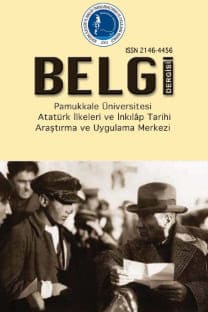1821 YUNAN İSYANI VE SULTAN 2. MAHMUD'UN BİLİNMEYEN BİR FERMANI
Osmanlı Devleti, 1821 Yunan isyanı, Sultan II. Mahmud, Şark meselesi
COTTON PRODUCTION AND COTTON POLICIES DURING INONU ERA IN TURKEY (1938-1950)
General Directorate of Cotton Works Çukurova, Cotton Production, Cotton Seed, World War II,
___
- - 182 Numaralı Isparta Şeriye Sicili, Milli Kütüphane İbn-i Sina Salonu, tasnif no: 20 H-6 - Ahmed Cevdet Paşa, Tarih-i Cevdet, C.XI, İstanbul 1309- Arıkan, Zeki., “1821 Yunan İsyanının Başlangıcı” , Askeri Tarih Bülteni, Şubat 1987, sayı:22- Armaoğlu, Fahir., 19. Yüzyıl Siyasi Tarihi (1789-1914), Türk Tarih Kurumu yay., Ankara 1999.- Beydilli, Kemal., “Küçük Kaynarca Antlaşması”,, Türkiye Diyanet Vakfı İslam Ansiklopedisi, C.26, s.524- 527. - Karal, Enver Ziya., Osmanlı Tarihi, C.V, 5. Baskı, TTK yay., Ankara 1988.- Köstüklü, Nuri., 1820- 1836 Yıllarında Hamid Sancağı ve Türkiye, Selçuk Üniversitesi Eğitim Fakültesi yay., Konya 1993.- Mc Carthy, Justin., Ölüm ve Sürgün, (Çeviren: Fatma Sarıkaya), TTK yay., Ankara 2012. - Mustafa Nuri Paşa, Netâyicü’l- Vukuat, (Neşet Çağatay neşri), Ankara 1980, C. III- IV
- ISSN: 2146-4456
- Yayın Aralığı: 2
- Başlangıç: 2011
- Yayıncı: Pamukkale Üniversitesi Atatürk İlkeleri ve İnkılap Tarihi Araştırma ve Uygulama Merkezi
OSMANLI DEVLETİ’NDE YETİM MALLARININ SÜRDÜRÜLEBİLİRLİĞİ HAKKINDA BİR ARAŞTIRMA
DEĞERLER EĞİTİMİ AÇISINDAN MİLLİ MÜCADELE’Yİ ANLATMANIN VE AKTARMANIN ÖNEMİ
OSMANLI MODERNLEŞMESİ’NDE TOPLUM KARŞISINDA ÖZNELEŞMEK; MEKTEB-İ TIBBİYE VE İÇTİMAİ TABİP GELENEĞİ
OSMANLI MODERNLEŞMESİN’DE TOPLUM KARŞISINDA ÖZNELEŞMEK; MEKTEB-İ TIBBİYE VE İÇTİMAİ TABİP GELENEĞİ
OSMANLI DEVLETİ'NDE YETİM MALLARININ SÜRDÜRÜLEBİLİRLİĞİ HAKKINDA BİR ARAŞTIRMA
CUMHURİYET TÜRKİYESİNİN EĞİTİM SİSTEMİNİN İNŞASI SÜRECİNDE HEYET-İ İLMİYE TOPLANTILARI
SİNOP MİLLET MEKTEPLERİ (1928-1935)
